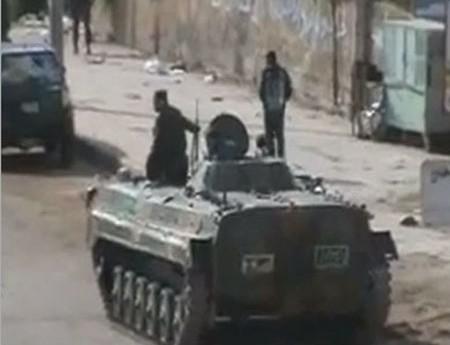
A tank in Homs, Syria. Photo credit: FreedomHouse, http://www.flickr.com/photos/syriafreedom/6731497685/
Thirteen Syrian opposition activists were killed during a daring and chaotic attempt to smuggle four foreign journalists out of a besieged Homs neighborhood of Baba Amr, human rights groups have reported. According to advocacy group Avaaz, which helped coordinate the rescue attempt, Syrian security forces attacked the party of 40 activists and journalists. The hit has increased speculation that the Bashar al-Assad regime is waging a war on the few journalists still reporting from inside Homs and elsewhere in Syria.
One of the journalists, injured British photographer Paul Conroy, managed to escape and make it across the border to Lebanon early on Tuesday but his three fellow journalists – Edith Bouvier, of Le Figaro, Javier Espinosa, of El Mundo, and William Daniels – were forced to retreat back into to Baba Amr. The 13 killed in the rescue attempt were among 102 people killed across Syria on Tuesday, according to the Local Coordination Committees, a Syrian activist group. The United Nations’ political officer, B. Lynn Pascoe, said that “well over” 7,500 Syrians are now known to have been killed since the uprising began last March 15, and that an average of 100 are dying daily as the Syrian government attempts to suppress revolts. The BBC reported that a new resolution is being drawn up at the United Nations to focus on humanitarian aid for Syria, in the hope both China and Russia, which have opposed previous votes, will back it.
American correspondent Marie Colvin, who worked for The Sunday Times, and French photographer Remi Ochlik were killed during a heavy bombardment of Homs last Wednesday. Those deaths came days after New York Times correspondent Anthony Shadid died of an asthma attack during a strenuous trek out of Syria across the mountainous Turkish border.
Rescues only going to get harder. The Washington Post said the failed rescue “underscores the dangers facing the underground networks of activists and smugglers set up to evacuate people injured in government attacks to hospitals in Lebanon, Turkey and Jordan. The same networks carry medical supplies such as blood bags and antibiotics into Syria for use in field hospitals and have been used by journalists to enter the country illegally.” The newspaper reported that “the evident discovery of the secret route” by Syrian security forces means “the network is now in jeopardy … leaving it unclear whether the remaining journalists can be evacuated.” The paper noted that efforts by the International Committee of the Red Cross and the Syrian Arab Red Crescent to negotiate safe passage out of Baba Amr for the journalists have failed.
Syria’s bloody policy of censorship and repression. An editorial in Voice of America regretted that the Syrian regime “is using violent means to block independent news coverage … They have denied entry to dozens of foreign journalists, and arrested, abducted, beaten, tortured and even killed journalists, photographers, and bloggers to prevent them from furnishing to the world proof that the Syrian military is slaughtering civilians.” The editorial reminded that UN Security Council resolution 1738 obliges states to ensure the safety of journalists in war zones, because journalists and media centers are neutral and cannot be targets. “Nonetheless, the Syrian government is persisting in its bloody policy of censorship and suppression of information. We condemn in the strongest possible terms the Syrian government’s use of detention and violence against journalists in order to maintain an information black-out. No amount of effort to stop information from leaking to the outside world will keep the press silent. ”
Shame on the Assad regime. An editorial in The Times (£) paid tribute to the Syrian activists involved in the evacuation attempts: “The price paid for helping Western journalists to report the slaughter of civilians in Homs has been great.” The newspaper said the the “whole enterprise was perilous” and “the dissidents’ sacrifice testified not just to their bravery, but to the importance placed by opponents of the Assad regime on the role of free media in reporting their situation … to put it bluntly, the dissidents knew that they could either protest, fight and die unseen and unreported and therefore probably pointlessly, or else have their sacrifice known to the world and be to some avail.” The newspaper said that blood is on the hands of the “brutal, pig-headed dictatorship of Bashar al-Assad … who bear the responsibility for the deaths in Syria, whether of a few Western journalists or of many Syrian citizens … It is they who have created the conditions for the present bloodshed by refusing all the reforms urged upon them over the years — and it is they who have prosecuted the campaign of shelling, torture and execution against their own countrymen.”
Self-regarding, navel-gazing hacks. At The Daily Mail Rights Minds comment hub Dominique Wilson asked “why do the world’s media stop to put the death of one foreign correspondent center stage while thousands of civilians are still dying in the wings?” Wilson praised Colvin’s “courage, determination and stamina” but suggested that the coverage may be because “we hacks are a particularly self-regarding, navel-gazing, bunch.” ”Perhaps the reporting of Marie Colvin’s death was, indeed, disproportionate,” said Wilson. “Yet if the blanket coverage devoted to its circumstances by her grief-stricken colleagues and journalist peers focused the international spotlight rather more clearly onto the bloodbath which is happening in Syria, even for the paltry 24-hour stint of a single news cycle, I would like to believe that Marie will not have died in vain. RIP.”

